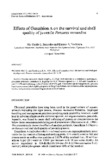Effects of Gusathion A on the survival and shell quality of juvenile Penaeus monodon
- Global styles
- MLA
- Vancouver
- Elsevier - Harvard
- APA
- Help

ดู/
วันที่
1991Page views
2,109ASFA keyword
AGROVOC keyword
Taxonomic term
เมตาดาต้า
แสดงระเบียนรายการเต็ม
Share
นามธรรม
Juvenile Penaeus monodon (body weight=10–20 g) were exposed to a commonly used organophosphate pesticide, Gusathion A, in ponds for 96 h. Prawns exposed to 1.5–150 ppb Gusathion A had 27–53% shell softening, with a 96 h LC50 of 120 ppb. Histopathological changes in the gills and hepatopancreas included slight hyperplasia of the gill epithelium, delamination of the hepatopancreatocytes, and general necrosis and degeneration of these tissues.
การอ้างอิง
Baticados, M. C. L., & Tendencia, E. (1991). Effects of Gusathion A on the survival and shell quality of juvenile Penaeus monodon. Aquaculture , 93(1), 9-19. https://doi.org/10.1016/0044-8486(91)90201-H
Type
ArticleISSN
0044-8486คอลเลกชัน
- Journal Articles [1258]
Related items
Showing items related by title, author, creator and subject.
-
An overview of the nutrition, feed and feeding techniques of prawn penaeid/shrimps
Piedad-Pascual, Felicitas (Philippine Council for Aquatic and Marine Research and Development, 1989)This paper echoes what transpired during the first International Conference of Penaeid Prawns/Shrimps held in Iloilo City in December 4-7, 1984, particularly on the Nutrition nd Feed Development. Around 25 papers were ... -
Series: Aquaculture extension manual; No. 19
Prawn hatchery operations
Parado-Estepa, Fe D.; Quinitio, Emilia T. ; Borlongan, Emeterio L. (Aquaculture Department, Southeast Asian Fisheries Development Center, 1996-05)
The manual, an updated version of the 1984 SEAFDEC/AQD manual, presents the underlying principles and step-by-step instructions of prawn larval and post-larval rearing. The techniques described are not only applicable to ...
; Borlongan, Emeterio L. (Aquaculture Department, Southeast Asian Fisheries Development Center, 1996-05)
The manual, an updated version of the 1984 SEAFDEC/AQD manual, presents the underlying principles and step-by-step instructions of prawn larval and post-larval rearing. The techniques described are not only applicable to ... -
The lowdown on world shrimp culture - II
Yap, Wilfredo G. (INFOFISH, 2001)This paper introduces some new members of the international shrimp culture club and goes on to discuss some recent technological innovations in the industry, particularly the polyculture of tilapia (mainly Oreochromis ...





